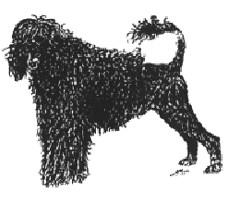Portuguese Water Dog
General Information - Portuguese Water Dog

Group:
Utility
Size:
Large
Lifespan:
10 –
14 years
Exercise:
High
Grooming:
Very high
Trainability:
Medium
Watchdog Ability:
High
Protection Ability:
Medium
Area of Origin:
Portugal
Date of Origin:
Middle Ages
Other
Names:
Cao de Agua
Original
Function:
Fishing aid
History
The Portuguese Water Dog is also known as the Portuguese Fishing Dog, the Diving Dog and the Sea Dog; whose homeland of Portugal, and is called the Cao de Agua which means "dog of the water". Although the ancestors of the Portuguese water dog are difficult to trace, what is known about this breed from Portugal is that it is a true seaman's companion. The strong, muscular dog is an excellent swimmer and diver and was used extensively on fishing boats to retrieve fish and fishing gear, as well as to carry messages from one boat to another, or to shore. It also served well as guard dog and friend. It is suited to country or city living, but shines most in a family of water sports enthusiasts.
Temperament
The lively Portuguese Water Dog enjoys human company and enjoys working for its master. It is affectionate, loyal and intelligent but can also be strong-headed and stubborn. The Portuguese Water Dog used to be used primarily in the Portuguese fishing industry to guard boats, carry messages between boats and retrieve anything that fell overboard. This breed gets along well with children and other dogs. Portuguese Water Dogs respond to tone of voice.
Upkeep
This active breed needs daily physical and mental exercise, preferably involving swimming and retrieving. Otherwise, it needs a long walk or jog or a vigorous romp. The Portuguese Water Dog can live outdoors in temperate climates, but it is generally happier living close to its family and spending days in the yard. Its coat needs combing every other day, plus monthly clipping or scissoring.
Portuguese Water Dog
A breed standard is the guideline which describes the ideal characteristics, temperament, and appearance of a breed and ensures that the breed is fit for function with soundness essential. Breeders and judges should at all times be careful to avoid obvious conditions and exaggerations, as well as being mindful of features which could be detrimental in any way to the health, welfare or soundness of this breed.
Breed Standard - Portuguese Water Dog
 General Appearance:
General Appearance: Robust, well balanced, rectangular in outline, very strongly muscled on shoulders. Hard, penetrating and attentive expression.
Characteristics: Very intelligent and tremendously energetic ‘fisherman’s dog’ with great swimming and diving traits.
Temperament: Pleasant disposition, self:willed but very obedient to owner. Brave and tireless.
Head and Skull:Large, well:proportioned skull slightly longer than muzzle, well defined occiput. Stop well defined. Muzzle tapers slightly. Median furrow extends for two-thirds the length of skull. Forehead has central furrow for two thirds of length of head. Frontal bones prominent. Nose wide, nostrils wide open. Black nose in black, black and white, and white dogs. Nose liver in brown, brown and white and brown tones.
Eyes: Medium, round, set well apart. Black or dark brown with dark eye rims.
Ears: Heart shaped, dropped, thin, set well above eye level, held close to head, except at back. Tips not below neck line.
Mouth: Scissor bite, jaws strong with a perfect, regular and complete scissor bite, i.e. upper teeth closely overlapping lower teeth and set square to the jaws, strongly developed canines.
Neck: Short, straight, strongly muscled. Carried high, no mane or dewlap.
Forequarters: Straight, strong boned and well muscled. Shoulders muscular and well laid. Pasterns long and upright.
Body: Length from point of shoulder to point of buttock slightly greater than height at withers. Withers are wide and not prominent. Chest wide and deep, reaching to elbow. Ribs well sprung and carried well back. Short, strong loin. Moderate tuck:up. Croup only slightly inclined.
Hindquarter: Straight and very strongly muscled, well angulated, buttocks long and well curved, strong hock, metatarsals long.
Feet: Round, rather flat, toes not too long or too knuckled up. Membrane reaching to tip of toes, covered with hair. Central pads very thick.
Tail: The tail is a distinctive feature of the breed and should be medium set, thick at base and tapering, not reaching below the hock. When the dog is moving, the tail should be carried gaily, curved above the level of the topline, but not necessarily in a full curve.
Gait/movement: Walking, lively short steps. A light trot and energetic gallop.
Coat: Profuse, covering whole body except under forelegs and thigh. Two distinct types, both without undercoats. (a) Hair fairly long, loosely waved with slight sheen, hair on head erect, ears well feathered. (b) Hair shorter, fairly harsh and dense, compact curls, lacking lustre, head hair similar to body, hair on ears somewhat wavy.
Muzzle and entire hindquarters from the last rib clipped. Two thirds of tail clipped from set on.
Colour: Black, white, various shades of brown, black and white, brown and white. Skin bluish under black, white, and black and white dogs.
Size: Height - dogs 50-57 cms (191/2-221/2 ins); bitches: 43-52 cms (17-201/2 ins).
Weight - dogs 19-25 kgs (42-55 lbs); bitches 16-22 kgs (35-48 lbs).
Faults: Any departure from the foregoing points should be considered a fault and the seriousness with which the fault should be regarded should be in exact proportion to its degree and its effect upon the health and welfare of the dog and on the dog’s ability to perform its traditional work.
Note: Male animals should have two apparently normal testicles fully descended into the scrotum.
DNZ No 661
Copyright Dogs New Zealand
30 May 18
Any departure from the foregoing points should be considered a fault and the seriousness with which the fault should be regarded should be in exact proportion to its degree and its effect upon the health and welfare of the dog and on the dog’s ability to perform its traditional work.




